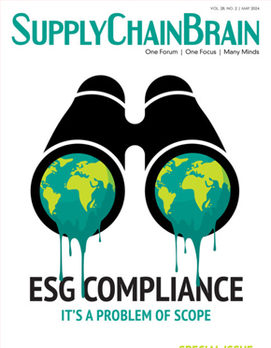
After nearly two years of disruption, supply chains across the globe remain dramatically out of sync, with congestion at seaports marking the latest problem in a long line of pitfalls. Ocean shipping, facilitated by ports, makes up the lion’s share of global trade, exacerbating the scale of this most recent issue. In 2021, the waiting time for vessels at ports skyrocketed, with 10% of the world’s container capacity idling.
Supply chain stresses are so fraught that the Biden administration has committed to working closely with retailers and rushing mitigation measures at U.S. ports.
In the face of major supply chain disruptions like port congestion, there are proactive measures you can take to mitigate the risks to your supply chain, starting with multi-tier visibility. Even if you know your first-tier suppliers are mainly domestic, enabling limited exposure to seaports, a staggering 50% of disruptions in supply chains occur below the first tier. Following are a few key insights into how your supply chain may be impacted by the reverberations of port congestion, and what you can do to protect yourself.
Supply Chain Visibility
In order to avoid the impacts of port congestion, it’s important to first increase visibility into your supply chain — ideally with a view of multiple tiers. These four steps are a great place to start:
- Use analytics to understand how much of your business’s goods flow through the congested port choke points and across each multi-tier product supply chain.
- Rank vulnerabilities of specific ports on a global level. It’s even more meaningful to assess the severity of the issue with respect to particular SKUs.
- Run delay scenarios to show when inventories for critical SKUs will become depleted.
- If your analysis shows that your company’s revenue and profits may severely suffer from lost sales of key products consider applying both short-term actions and long-term initiatives.
Risk Mitigation Strategies
Once you’ve established visibility into your supply chain, it’s important to implement tangible strategies to act on that information and reduce your overall risk.
Professor David Simchi-Levi at the MIT Data Science Lab has long advocated for stress-testing supply chains in order to understand risk exposures and support proactive analytical approaches. Modeling supply chain data from China’s COVID-19-related restrictions, his team correctly predicted that it would take five weeks for U.S. companies to feel the impact. By leveraging this lead time, companies can have informed, proactive discussions about mitigating an event like severe port congestion.
When engaging in these discussions, supply chain leaders should consider these key strategies:
- Investigate rerouting options. Not all ports are facing extreme congestion and can thus be used as alternatives. Shifting from sea to rail, when possible, proved to be a successful strategy during the height of the pandemic. However, even with more lead time, route alternatives aren’t always the simple solution they appear to be, particularly in the U.S., says Robert Handfield, a supply chain professor from North Carolina State University. Smaller ports are too shallow for major vessels, shipping time can be too long through the deeper canals (e.g., the Panama Canal), and there might not be enough truckers to travel to alternative, remote ports.
- Maintain a playbook for emergency backup transportation options. For some companies, reverting to more expensive air freight or shifting to other modes of transport might be worth the cost to avoid potential production outages or lost sales. Though large companies like Walmart or Home Depot can afford to charter their own vessels in these situations, not all can. When faced with a potential delay, the ability to pre-book emergency transportation for alternative modes has helped many companies avoid surprise costs during the pandemic.
- Find flexibility in your production schedules to cope with delays. To prevent or minimize lost sales, you can potentially shift your schedule to avoid waiting for the delayed parts and focus on using the idle production assets effectively.
- Adjust inventory policies for the SKUs with high port-concentration risks. Adjusting inventory policies might not alleviate the immediate problem, but as ports or other weak links persist, lead times will have to be adjusted to place orders earlier and increase the company’s buffer stock.
- Source from alternative suppliers or avoid ports altogether. Domestic sourcing is increasing. Handfield says Mexico will become a stronger sourcing option for U.S. companies, due to its accessibility by rail. Yet, alternative sourcing will have near-term limits. According to McKinsey research, only 26% of global trade can reasonably shift to other countries.
Ultimately, many companies will simply need to accept inevitable increases in shipping and input costs through this period of disruption, signaling margin erosion and price inflation. Companies can also expect that inflation-indexed pricing in customer contracts will rise in importance as a mitigation strategy.
Is Improvement on the Horizon?
Most experts believe the supply chain bottlenecks, exemplified by recent port congestion, will last late into 2022 and possibly 2023. Much will depend on whether or not demand for consumer goods remains high. The reduction of government stimulus and efforts by central banks to reduce non-transitory inflation might eventually suppress demand. At the same time, additional hiring and production capacity increases will increase supply.
Regardless, COVID-19 has unveiled the need in the U.S. to upgrade infrastructure, and for federal support to resolve port disruption. The adjacent ports of Los Angeles and Long Beach, California, are set to become more automated like their global counterparts, which are twice as productive and are more efficient at sorting containers.
The latest supply chain troubles reinforce the importance of understanding the multi-tier, product-specific flows of goods through the supply chain. Connecting your procurement and transportation management systems to a living knowledge graph of global supply chains enables you to ask the right questions quickly, anticipate bottlenecks before they occur, and avert losses and missed deliveries.
Tobias Larsson is head of supply chain at Altana AI.



.jpg?height=100&t=1715228265&width=150)
.jpg?height=100&t=1715141311&width=150)


